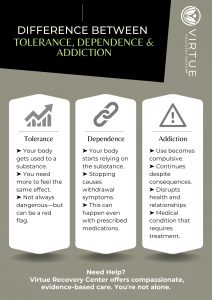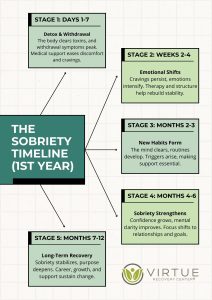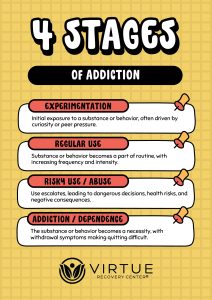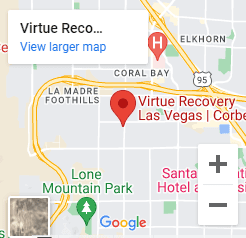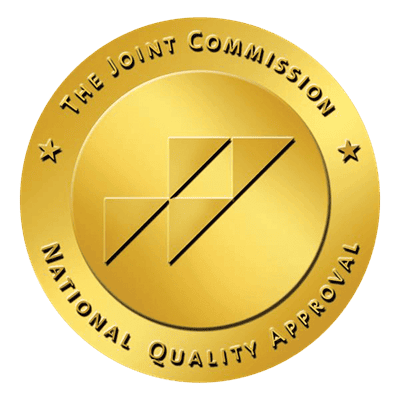Key Takeaways
- Klonopin (clonazepam) is a prescription benzodiazepine used to treat seizures and panic disorders, but it can be highly addictive.
- Long-term use can lead to tolerance, dependence, and addiction, making it difficult to stop without medical supervision.
- Withdrawal symptoms can be severe, including seizures, anxiety, and insomnia, and require a gradual detox process.
- Overdosing on Klonopin, especially when mixed with alcohol or opioids, can cause life-threatening respiratory depression.
- Professional addiction treatment is essential for a safe and lasting recovery.
Introduction
Klonopin, also known as clonazepam, is a prescription benzodiazepine used to treat seizures, panic attacks, and anxiety disorders. It works by slowing down the central nervous system, producing a calming effect. While useful in medical settings, Klonopin has a high potential for addiction, especially when taken for long periods.
Many people start taking Klonopin as prescribed but gradually develop tolerance. Over time, they need higher doses to feel the same effects, which can lead to dependence and addiction. Stopping Klonopin suddenly can cause severe withdrawal symptoms, making it difficult to quit without professional help.
Understanding the risks of Klonopin addiction, its effects on the body, and available treatment options can help individuals take the first step toward recovery.
How Klonopin Abuse Affects the Brain and Body
Klonopin is a sedative that enhances the effects of gamma-aminobutyric acid (GABA), a neurotransmitter that slows brain activity. This helps reduce anxiety, muscle tension, and seizures. However, prolonged use can interfere with the brain’s natural ability to regulate mood and stress, leading to physical and psychological dependence.
People who take Klonopin for an extended period may experience memory issues, drowsiness, dizziness, and difficulty concentrating. Some users also report feeling emotionally numb or disconnected. Over time, the brain becomes dependent on the drug, making it harder to function without it.
Signs and Symptoms of Klonopin Addiction
Recognizing Klonopin addiction can be difficult because many people believe they need the drug for medical reasons. However, dependence develops when someone relies on Klonopin to function daily and experiences withdrawal when they try to stop.
A person struggling with addiction may increase their dosage without medical approval or take Klonopin more frequently than prescribed. They may also experience difficulty concentrating, mood swings, and episodes of confusion. In some cases, they may visit multiple doctors to obtain extra prescriptions or attempt to buy the drug illegally.
As dependence grows, physical symptoms can appear, including slurred speech, muscle weakness, and excessive drowsiness. Some individuals struggle with insomnia and irritability between doses. Long-term users may feel trapped, unable to quit even when the drug negatively impacts their work, relationships, and health.
The Dangers of Overdosing on Klonopin and Abuse
Using Klonopin outside of medical guidelines increases the risk of overdose and dangerous side effects. When taken in high doses or combined with alcohol or opioids, Klonopin can slow breathing and heart rate to dangerous levels, leading to unconsciousness, coma, or death.
Signs of a Klonopin overdose include extreme drowsiness, confusion, and difficulty breathing. If someone becomes unresponsive or has blue lips or fingertips, immediate emergency medical attention is required.
Long-term use of Klonopin can also cause cognitive impairment, depression, and an increased risk of developing other substance use disorders. Over time, the drug can affect a person’s ability to think clearly, regulate emotions, and maintain motivation for daily activities.
Klonopin Detox and Withdrawal: What to Expect
Quitting Klonopin abruptly can be dangerous, as withdrawal symptoms can include severe anxiety, tremors, and seizures. The safest way to stop using Klonopin is through a medically supervised detox, where doctors help reduce the drug gradually to prevent extreme withdrawal reactions.
Withdrawal symptoms usually begin within a few hours to a day after the last dose and can peak within one to three days. During this time, individuals may experience nausea, rapid heartbeat, sweating, and intense cravings.
For some, withdrawal lasts for several weeks, with lingering symptoms such as insomnia, depression, and difficulty concentrating. In rare cases, individuals may experience post-acute withdrawal syndrome (PAWS), where mood swings and anxiety persist for months after stopping the drug.
Because of the risks associated with withdrawal, a structured detox program can provide medical supervision and symptom management to make the process safer and more comfortable.
Klonopin Addiction Treatment Options
Overcoming Klonopin addiction requires a combination of detox, therapy, and long-term support. Medical professionals create personalized treatment plans to address both physical dependence and psychological triggers.
Medical Detox for Safe Withdrawal
During medical detox, patients are monitored for withdrawal symptoms and may receive medications to ease discomfort. This process helps individuals safely taper off Klonopin while minimizing the risk of seizures and severe anxiety.
Inpatient vs. Outpatient Treatment
Inpatient rehab provides a structured environment where individuals receive round-the-clock medical care, counseling, and group therapy. This is the best option for those with severe addiction or a history of relapse.
Outpatient treatment allows individuals to attend therapy sessions while living at home. This option is suitable for those with mild to moderate addiction who have a strong support system.
Therapy and Behavioral Treatment
Therapy plays a crucial role in long-term recovery. Cognitive Behavioral Therapy (CBT) helps individuals identify triggers, change negative thought patterns, and develop healthier coping strategies. Support groups like Narcotics Anonymous (NA) provide peer encouragement and accountability.
Conclusion
Klonopin addiction is a serious condition that affects both the mind and body. While the drug is effective for treating seizures and anxiety, long-term use increases the risk of dependence, withdrawal symptoms, and overdose.
The safest way to stop using Klonopin is through medical detox and addiction treatment. Professional care can help individuals manage withdrawal symptoms, develop healthier coping strategies, and prevent relapse.
If you or a loved one is struggling with Klonopin addiction, professional help is available. Contact Virtue Recovery Las Vegas at 866-520-2861 today to start your recovery journey.
FAQs About Effects of Klonopin and Addiction Treatment Programs
How addictive is Klonopin misuse?
Klonopin is highly addictive, especially with long-term use. Many people develop tolerance and dependence within a few weeks of regular use.
Can you quit Klonopin cold turkey?
No. Quitting suddenly can be dangerous and lead to severe withdrawal symptoms, including seizures and panic attacks. A gradual tapering plan under medical supervision is recommended.
How long does Klonopin withdrawal last?
Withdrawal symptoms typically last one to two weeks, but some people experience lingering effects for months.
What is the best treatment for Klonopin addiction?
A combination of medical detox, therapy, and long-term support provides the best chance for lasting recovery.
Where can I get help for Klonopin addiction?
If you or someone you know is struggling with Klonopin addiction, call Virtue Recovery Las Vegas at 866-520-2861 for professional treatment and support.
Resources
https://www.webmd.com/drugs/2/drug-920-6006/klonopin-oral/clonazepam-oral/details





